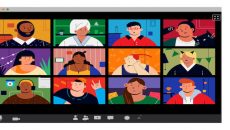Our post-COVID world suggests online teaching is here to stay, even though we have returned to physical classrooms. The pandemic accelerated the adoption of digital learning tools, reshaping expectations around flexibility and access. As a result, more institutions than ever are now embracing dual-mode learning. Both programs and courses are offered online and in person to give students choice and flexibility.
The debate over online versus face-to-face teaching continues to grow. Some argue that in-person learning still offers the most effective and engaging experience, with real-time interaction and a structured environment. Others believe online education offers greater flexibility, accessibility, and the ability to learn at one’s own pace. Each side makes valid points.
My position is supported by evidence from teaching practices in large first year university courses. This is documented in two of my published journal papers, both of which reach the same conclusion.
‘When thoughtfully prepared and effectively delivered, online teaching can provide students with an equivalent learning experience and consistent academic outcomes. In short, online learning can match in-person teaching—if done right. Here are my insights on how to make it work!”
1. Conduct your live lectures effectively in a hybrid classroom, accessible to both in-person and online students.
Host your large live lectures in a hybrid classroom setting, where both in-person and online students can participate in real-time. This approach ensures that all students, regardless of location, receive the same level of interaction and engagement. By utilizing tools like live streaming and interactive platforms, you can seamlessly integrate both cohorts into discussions, Q&A sessions, and collaborative activities.
To make the most of a hybrid classroom, teachers should leverage technology to create an inclusive learning environment. Use tools like interactive whiteboards and chat features to encourage real-time collaboration between in-person and online students.
Additionally, being mindful of the pacing and ensuring that online participants are as involved as those in the physical classroom is crucial for keeping the learning experience balanced and effective. This is important since unequal engagement would lead to disparities in learning outcomes, where online participants may feel disconnected when they feel overlooked compared to those physically present.
Teaching in a hybrid classroom can feel a bit daunting for instructors using it for the first time. It is a good idea to get proper orientation and training from your institution’s tech support before your first class. If possible, have a tech support person on standby during that first session to help things run smoothly and give you peace of mind.
2. Break large lectures into smaller workshop sessions (in-person or online), whilst ensuring that learning activities are effectively replicated.
Students learn foundational theories and concepts in the large lecture setting. In contrast, smaller workshops offer opportunities for active and collaborative learning. There, students can better interact with peers and engage more directly with their teachers. Offer students the choice to attend workshops either face-to-face or online, based on their preference or needs.
It is essential that we create a detailed and systematic learning plan for the workshop. This plan should clearly outline the learning activities, specifying what will occur in the physical classroom and how to replicate those activities in the online environment.
For example, if group work is done around a table in class, replicate this by using breakout rooms in your online teaching platform for online students. Be sure also to record your online workshop session. Share the recording with both in-person and online students who were not able to attend.
3. Properly design your course site with supportive asynchronous activities for both cohorts, allowing flexibility and continuity in learning for all students.
Experienced educators know learning happens both before and after live classroom sessions. In fact, these components are crucial as they allow students to prepare, review, reinforce and apply what they have learned. This deepens their understanding and retention. And yes, they are equally important for both in-person or online students.
Online asynchronous activities should be structured with clear objectives and aligned with both online and face-to-face learning. Activities like pre-recorded contents, quizzes, and discussion boards should be made interactive and engaging, using multimedia to cater to various learning styles. Consistent formatting and timing across both cohorts, along with regular feedback and checkpoints, ensure all students have a unified learning experience.
4. Lastly, the same assessment should be given to both cohorts to ensure fairness and consistency in evaluation.
If it is an assignment, both cohorts should have the same time to complete and submit it via the same online submission point by the same deadline.
If it is an exam, maintaining consistency becomes more complex but is achievable with careful planning and clear coordination. Both cohorts should sit the exam simultaneously, whether in person or online. For online students, employ proctoring tools or monitored Zoom sessions to ensure academic integrity. The format, duration, and exam conditions should be as similar as possible to provide a fair and equitable assessment experience for all.
5. The evidence I have is clear: implementing these strategies leads to equitable and consistent learning experiences and academic outcomes.
Would you like to read more about my teaching strategies, data, methodology, estimation techniques, and results? I have two papers that explore these in detail. The first, from 2019, examines my dual-mode teaching approach in a large first-year statistics course. This work was notably cited by UNSW in their June 2020 policy discussion paper on dual-mode teaching during COVID-19, where my strategies were adopted as guiding principles. The second, published in 2023, applies similar principles to a mixed-mode teaching model in a large first-year economics course.
In conclusion, it is time to stop debating whether face-to-face or online is better. Instead, focus on thoughtful preparation and effective delivery. I hope the strategies I shared have offered useful insights.
It is however acknowledged that despite the solid framework, adoption may still be hindered by staff concerns over workload and technical demands with managing hybrid and dual mode classes. Additionally, limited institutional support and inadequate infrastructure can further hinder effective implementation and adoption.

Tommy Soesmanto is a senior lecturer and Director of Commerce Programs at Griffith Business School, Griffith University. An award-winning educator, Tommy is highly regarded for his ability to turn around challenging foundation courses like economics and business statistics, making them active, authentic and collaborative learning experiences for his students.







It was clear pre-COVID that online teaching was something which should be taken seriously. The key to offering students choice is to have teachers trained to teach this way , start with an online course design and add optional classroom activities. It doesn’t work well the other way around.
A debate over online versus face-to-face teaching is pointless. If a student can’t get to class, then online is better than nothing. Students are already in effect studying online, even when they are compelled to come to class.
Seven years before COVID I decided I wanted to know how to teach international university students online. So I became a student of online learning, at an online university, first one 1,000 km away, the 13,000 km in another country. To my surprise I found this less stressful and more successful than being an on campus student. Apart from the ease of fitting the online study into my schedule, this was because the online courses were well designed. University students have a more stressful experience than necessary because the academics teaching them are not trained in how to teach, in a classroom, let alone online and are not qualified to design courses in any form.
After that I designed my courses of online delivery with optional classroom elements. When COVID struck, I simply changed the address for real time components from a classroom to a Zoom room.